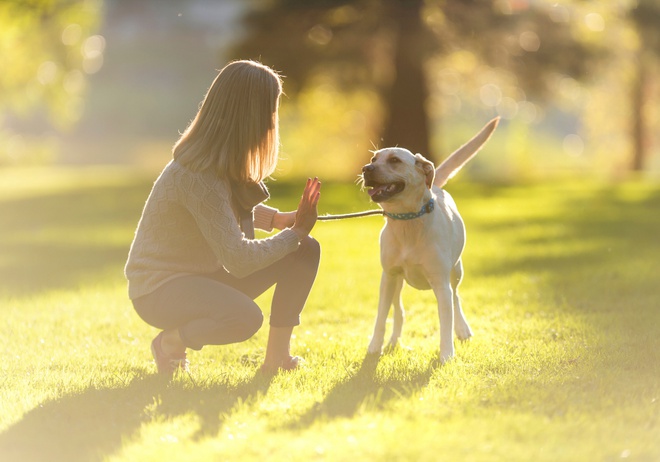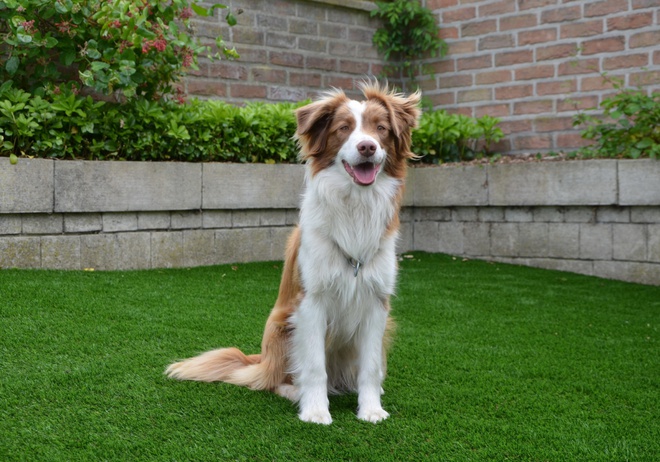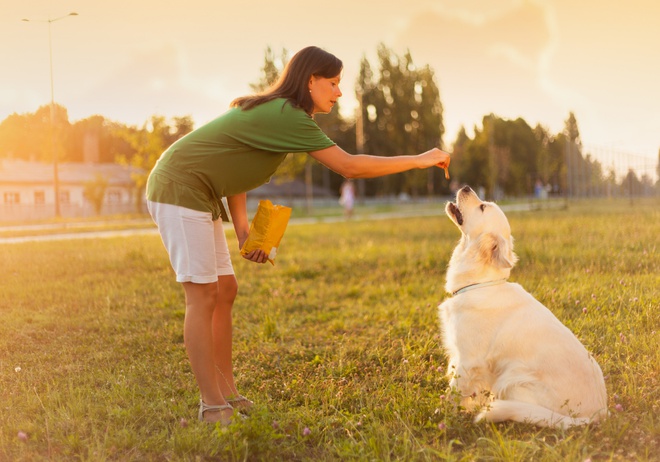How to teach a dog to stay?
Stay is one of the most basic and useful commands for your dog to learn. It can come in handy in various situations, either for your convenience or for your dog’s safety. Take a look at 6 simple steps to teach a dog to stay that we provide in this article.

Reading time : 4 min
As all dog owners know, dogs may break position during training. The goal is to improve household obedience and control their impulses for safety and well-being.
Teaching a dog to stay is simple, and the cue can be used in dog sports or daily life. Apply the three Ds (distance, duration, distraction) to build stronger focus.
Before starting, check if your dog is comfortable in sit, down or stand. Use a movement lure if needed, and add a clear release cue for dogs with hearing issues or vision issues.
TOPICS
Reasons for teaching your dog to stay

Teaching your dog basic commands is a good way of controlling their behaviour. In this aspect, training a dog to stay is particularly useful, as it can help you out in many situations when your dog’s natural reaction would be to move.
Dog’s safety
Being a dog owner, you might have already encountered yourself in situations when your dog’s health or safety were endangered. When your dog knows the stay command, you can be calm that they will stay by your side before crossing the street, or when you have to clean up the broken glass from the floor.
Dog’s obedience
Controlling your dog’s impulses will be beneficial not only for the pet’s safety, but by making them more obedient, you can prevent unwanted behaviours. If you struggle with your dog running to the entry door when you have guests or hurrying back home after a walk before you manage to clean them up, teaching the stay command can make your life as an owner much easier.
6 steps to teach a dog to stay

Step One: Choose a location
As with any other new trick, teaching your dog to stay will require a lot of patience and consistency from you and plenty of concentration from your dog. To make the process easier and more pleasant for both sides, start the training in a quiet location, where your dog will not be exposed to too many distractions. The place you choose for training should also be familiar to the dog, so that they do not have the urge to run around exploring it.
Step Two: Have your dog in the starting position
No matter whether you’ll want your dog to learn to hold their stay in sit, down or stand position, they have to be familiar with this command before you move further. Start by asking your dog to get in the lying, sitting or standing.
Step Three: Reward the dog
When your dog successfully executes your command, praise them, and reward them with a treat. Give your dog the treats in the way that the dog doesn’t have to leave the position they are in. Make sure that you use healthy training snacks that your dog likes. The better the prize, the more motivation the dog will have to train. This type of training, namely rewarding the dog after they successfully do what you ask them to, is part of positive reinforcement training.
Step Four: Repeat the steps, building the duration
Repeat several times all the previous steps, increasing the duration between the sit, stand, or down command and the reward you give to your dog. Do not hurry and build the duration gradually. At first, your dog will be able to stay in position just for several seconds, and it might take a lot of practice to increase the length to up to 15 seconds.
Step Five: Introduce stay and release commands
When your dog is staying in the position for at least 15 seconds, you can move on to further steps: introducing stay and release commands. Once your dog gets in the starting position, ask them to stay in the position by saying “stay,” and give the reward when they still hold the stay. Then, give a release command – this can be either a hand signal or a verbal command like “ok” or “go” – and toss the treat a bit further away from the dog, so that they have to get out of the position to retrieve it.
Step Six: Increase the distance and add distractions
As mentioned above, it’s best to start the training in the calm and quiet environment, but once your dog learned the behaviour, they should be ready to train with small distractions. Gradually increase the distance between yourself and the dog when giving the command. You may also start training in other locations, at first just in another room of the house and later trying it outdoors, on walks or in a park.
10 questions to test your pet training knowledge
Do you know everything there is to know about training dogs and cats? Answer our 10 questions to find out!
Extra tips on training your dog to stay

Similarly to other types of training, the key to success is keeping sessions short and positive. Use a clear release cue and reward progress with treats. There are also three factors that play an important role in stay training. Known as the Three Ds: Duration, Distance and Distractions. When your dog already knows the behaviour, increase the challenge step by step, avoiding a break position.
Building duration
Duration is the time your dog holds the stay. At the start it may be 2–3 seconds, but you should increase gradually. If they break position before the release cue, return to a shorter duration. Reward with treats and avoid using a movement lure, which may confuse the dog and delay progress.
Increasing the distance
Once your dog stays for longer periods, begin adding distance. Work slowly, as in household obedience or dog sports, where calm focus is key. Move one step back while giving the cue, but always return to release your dog. This routine helps them stay confident and prevents unwanted breaking of position.
Introducing distractions
Practice the stay command in various settings to proof against distractions. Lower criteria if needed and rebuild with patience. Dogs with hearing issues or vision issues may require clearer signals or closer distance. Use higher value treats and consistent cues to keep motivation strong and ensure lasting success.
Conclusion
Training a dog to stay is a great way to control their behaviour and avoid many unpleasant or even dangerous situations, thus making your dog safe and happy. If you follow the training steps in our guide, learning the stay command will become an easy task for your dog, and you can be sure the training sessions will be successful.
Continue reading our guide
This article is a part of a complete guide on the subject. Do not miss the next chapters.
Do you know everything there is to know about training pets?
Answer our 10 questions to test your pet training knowledge.
